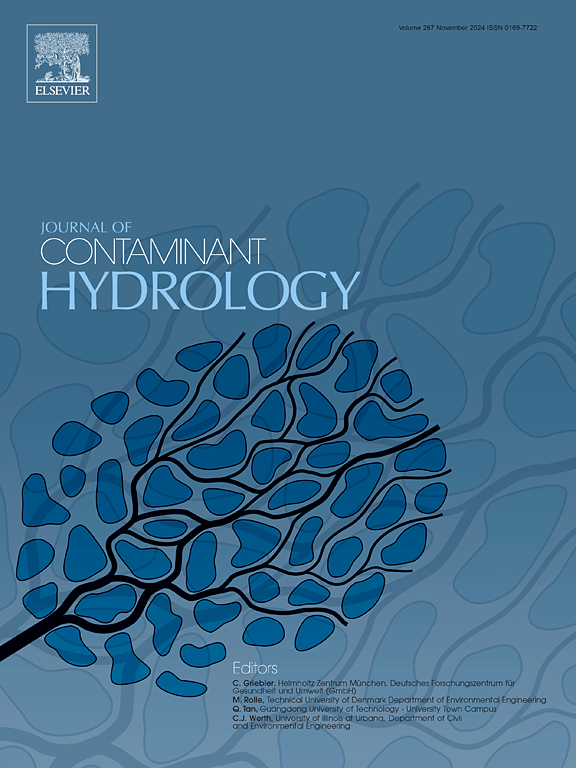应用海绵铁碳从污泥混合物中富集厌氧氨氧化菌并耦合反硝化技术降解工业废水
IF 3.5
3区 环境科学与生态学
Q2 ENVIRONMENTAL SCIENCES
引用次数: 0
摘要
在Fe/C = 2, C/N≤2,温度为30℃的条件下,对铁碳耦合微电解(ICME) -厌氧氨氧化(anammox) -反硝化工艺处理工业废水进行了优化。本试验第76天,ICME偶联富集了混合污泥中的氨氧化菌(AnAOB)和反硝化菌(DB)。第78天手术稳定。操作过程中COD和TN的去除率分别为86.20%和87.12%,而对照组(不含铁和碳)的去除率分别为74.30%和60.31%,分别高出11.9%和26.81%。值得注意的是,从第76天到第100天,系统中AnAOB的丰度从0.44%增加到1.43%。高通量测序结果表明,Candidatus_Kuenenia是一个关键的厌氧氨氧化细菌。实验结果表明,在工业废水的水质条件下,ICME工艺可以快速富集厌氧氨氧化菌,改变污泥的微生物群落结构,提高某些DB和Candidatus_Kuenenia对水质的耐受性。通过与铁碳结合,实现了混合污泥的快速改性,建立了铁碳微电解耦合反硝化厌氧氨氧化工艺,为处理工业废水提供了一定的参考价值。本文章由计算机程序翻译,如有差异,请以英文原文为准。
Application of sponge iron-carbon to enrich anaerobic ammonia-oxidizing bacteria from sludge mixture and coupled denitrification for degradation of industrial wastewater
For the treatment of industrial wastewater, coupled iron‑carbon micro-electrolysis (ICME) with anaerobic ammonia oxidation (anammox) and denitrification was optimized under the following conditions: Fe/C = 2, C/N ≤ 2, and the temperature was 30 °C. The coupled ICME enriched ammonia-oxidizing bacteria (AnAOB) and denitrifying bacteria (DB) in the mixed sludge on the 76th day of the present experiment. Stable operation was achieved on the 78th day. The COD and TN removal rates during the operation were 86.20 % and 87.12 %, respectively, while the control group (without iron and carbon) had removal rates of 74.30 % and 60.31 % which were 11.9 % and 26.81 % higher, respectively. Notably, the abundance of AnAOB in the system increased from 0.44 % to 1.43 % during the operation from day 76 to day 100. High-throughput sequencing demonstrated that Candidatus_Kuenenia was a key anaerobic ammonia-oxidizing bacterium. Based on the experimental results, the ICME process could rapidly enrich anaerobic ammonia-oxidizing bacteria to change the microbial community structure of the sludge under the water quality conditions of industrial wastewater and increasing the tolerance of certain DB and Candidatus_Kuenenia to water quality. By combining with iron‑carbon, the rapid modification of mixed sludge was achieved, and the iron‑carbon micro-electrolysis coupled denitrification anaerobic ammonia oxidation process was established, which provides a certain reference value for treating industrial wastewater.
求助全文
通过发布文献求助,成功后即可免费获取论文全文。
去求助
来源期刊

Journal of contaminant hydrology
环境科学-地球科学综合
CiteScore
6.80
自引率
2.80%
发文量
129
审稿时长
68 days
期刊介绍:
The Journal of Contaminant Hydrology is an international journal publishing scientific articles pertaining to the contamination of subsurface water resources. Emphasis is placed on investigations of the physical, chemical, and biological processes influencing the behavior and fate of organic and inorganic contaminants in the unsaturated (vadose) and saturated (groundwater) zones, as well as at groundwater-surface water interfaces. The ecological impacts of contaminants transported both from and to aquifers are of interest. Articles on contamination of surface water only, without a link to groundwater, are out of the scope. Broad latitude is allowed in identifying contaminants of interest, and include legacy and emerging pollutants, nutrients, nanoparticles, pathogenic microorganisms (e.g., bacteria, viruses, protozoa), microplastics, and various constituents associated with energy production (e.g., methane, carbon dioxide, hydrogen sulfide).
The journal''s scope embraces a wide range of topics including: experimental investigations of contaminant sorption, diffusion, transformation, volatilization and transport in the surface and subsurface; characterization of soil and aquifer properties only as they influence contaminant behavior; development and testing of mathematical models of contaminant behaviour; innovative techniques for restoration of contaminated sites; development of new tools or techniques for monitoring the extent of soil and groundwater contamination; transformation of contaminants in the hyporheic zone; effects of contaminants traversing the hyporheic zone on surface water and groundwater ecosystems; subsurface carbon sequestration and/or turnover; and migration of fluids associated with energy production into groundwater.
 求助内容:
求助内容: 应助结果提醒方式:
应助结果提醒方式:


